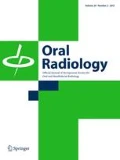Abstract
Schwannoma is a benign nerve sheath tumor composed of Schwann cells. Schwannomas originating from ganglia are rare, and schwannomas of the submandibular ganglion or glandular branches have not been reported to date. We present a case of a Japanese woman in her sixties with a submandibular schwannoma originating from the submandibular ganglion, mimicking a submandibular gland tumor on radiological findings. As the radiological findings were nonspecific, the key finding in the present case may be the characteristic location of the tumor suspended from the undersurface of the lingual nerve and situated above the deep portion of the submandibular gland.



Similar content being viewed by others
References
Das Gupta TK, Brasfield RD, Strong EW, Hajdu SI. Benign solitary schwannomas (neurilemomas). Cancer. 1969;24:355–66.
Diaz DD, Kennedy KS, Parker GS, White VJ. Schwannoma of the submandibular gland. Head Neck. 1991;13:239–42.
Kang GC, Soo KC, Lim DT. Extracranial non-vestibular head and neck schwannomas: a ten-year experience. Ann Acad Med. 2007;36:233–8.
Bhatia M, Nirhale DS, Athavale VS, Calcutawala M. Schwannoma over submandibular region: a rare presentation. Trop J Med Res. 2015;18:48–50.
Anil G, Tan TY. Imaging characteristics of schwannoma of the cervical sympathetic chain: a review of 12 cases. Am J Neuroradiol. 2010;31:1408–12.
Beaman FD, Kransdorf MJ, Menke DM. Schwannoma: radiologic-pathologic correlation. Radiographics. 2004;24:1477–81.
Kato H, Kanematsu M, Ohno T, Oshima K, Nagano A, Hatano Y, et al. Intraosseous schwannoma of the ilium. Clin Imaging. 2015;39:161–4.
van Rijswijk CS, Kunz P, Hogendoorn PC, Taminiau AH, Doornbos J, Bloem JL. Diffusion-weighted MRI in the characterization of soft-tissue tumors. J Magn Reson Imaging. 2002;15:302–7.
Sener RN. Diffusion magnetic resonance imaging of solid vestibular schwannomas. J Comput Assist Tomogr. 2003;27:249–52.
Einarsdóttir H, Karlsson M, Wejde J, Bauer HC. Diffusion-weighted MRI of soft tissue tumours. Eur Radiol. 2004;14:959–63.
Pavlisa G, Rados M, Pazanin L, Padovan RS, Ozretic D, Pavlisa G. Characteristics of typical and atypical meningiomas on ADC maps with respect to schwannomas. Clin Imaging. 2008;32:22–7.
Gaddikeri S, Hippe DS, Anzai Y. Dynamic contrast-enhanced MRI in the evaluation of carotid space paraganglioma versus schwannoma. J Neuroimaging. 2016;26:618–25.
El Shahat HM, Fahmy HS, Gouhar GK. Diagnostic value of gadolinium-enhanced dynamic MR imaging for parotid gland tumors. Egypt J Radiol Nucl Med. 2013;44:203–7.
Asaumi J, Yanagi Y, Hisatomi M, Matsuzaki H, Konouchi H, Kishi K. The value of dynamic contrast-enhanced MRI in diagnosis of malignant lymphoma of the head and neck. Eur J Radiol. 2003;48:183–7.
Yudin A. Claw sign or beak sign. Metaphorical signs in computed tomography of chest and abdomen. Cham: Springer; 2014. p. 125.
Benz MR, Czernin J, Dry SM, Tap WD, Allen-Auerbach MS, Elashoff D, et al. Quantitative F18-fluorodeoxyglucose positron emission tomography accurately characterizes peripheral nerve sheath tumors as malignant or benign. Cancer. 2010;116:451–8.
Acknowledgements
The authors thank Ms. Yukiko Ishii for her illustration in Fig. 3.
Author information
Authors and Affiliations
Corresponding author
Ethics declarations
Conflict of interest
Akira Baba, Katsuhiko Sakai, Yumi Okuyama, Hideomi Yamauchi, Nobuhiro Ogino, Kazuhiko Hashimoto, Yasuaki Hasegawa, Yuki Seto, Shinji Yamazoe, Yuko Kobashi, Takuji Mogami, Takeshi Nomura, and Hiroya Ojiri declare that they have no conflict of interest.
Human rights statement
All procedures followed were in accordance with the ethical standards of the responsible committee on human experimentation (institutional and national) and with the Helsinki Declaration of 1964 and later versions.
Informed consent
Informed consent was obtained from the patient for being included in the study.
Animal rights statement
This article does not contain any studies with animal subjects performed by any of the authors.
Rights and permissions
About this article
Cite this article
Baba, A., Sakai, K., Okuyama, Y. et al. Schwannoma assumedly originating from the submandibular ganglion or glandular branches radiologically mimicking a submandibular gland tumor. Oral Radiol 35, 189–193 (2019). https://doi.org/10.1007/s11282-018-0332-1
Received:
Accepted:
Published:
Issue Date:
DOI: https://doi.org/10.1007/s11282-018-0332-1




